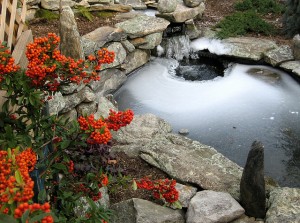For those hardy souls who brave the frigid elements with their Living Jewels, the question is often asked—how do I keep my koi pond (and my koi) from freezing?
When it comes to making sure that your koi have the best chance of surviving the winter, you are probably more stressed about your cold or frozen pond than the koi are. A koi’s evolutionary trajectory has made them resistant to some fairly extreme temperatures.
However, allowing for proper gas exchange (toxic gases out and oxygen in) is a real consideration in a closed system. In a well maintained pond, one that has been properly prepared for winter, toxins that can result from decomposing organic matter (like leaves and uneaten food) won’t accumulate as quickly, but they will add up over time.
Quick Winter Prep Tips
|
And even though the rate of gas production is slowed, it still has to be allowed to escape a pond so that it doesn’t build up to dangerous levels. A hole a few feet in width will allow this to happen.
So how to accomplish this?
Deicer
It is a pretty simple device that uses electricity to generate enough heat to melt the ice surrounding it and allow for gas exchange. There are a number of options available that come as floating or submerged units.
Deicer manufacturers will have recommendations for the most effective wattage—ranging from 100W all the way up to 1500W—based on the pond’s volume. The higher the wattage, the higher your electric bill is likely to be if you are running it during the coldest months of the year.
Before you commit to a deicer, do a little investigating as to what your kilowatt per hour rate is (the most recent National average was $12.93/hr). Some sites and enthusiasts will advocate for stock tank-type deicers as a more cost effective way to maintain a hole in the ice.
Pros
The sustained heat will help to keep a hole in the ice at lower temperatures allowing for gas exchange, which helps with water quality.
Cons
The cost. It can be pretty pricy to keep a deicer on for the coldest part of the year.
In some extreme cases, the deicer can actually get frozen into the ice.

Aerator
This is a fairly simple device that can be used year round. In the winter, the compressed air that is pushed into the water causes a bubbling action that then creates moving water, making it more difficult for the water to freeze.
Pros
Aerators are a less expensive alternative to deicers. Even on the higher end of a kW/hr spectrum, the power draw is substantially less than that of running a heater or deicer.
A functioning aerator also encourages circulation which will help to push the toxic gases out while simultaneously diffusing some oxygen into the pond.
Cons
Positioned incorrectly, it can cause all the warmer water in the lower thermocline of your pond to go to the surface. This can cause fish death as they will rely on the slightly warmer temperatures at the bottom to stop from freezing. Don’t put it in the deepest part of your pond. Keep it off the bottom and about 12-18” from the surface (depending on the depth of your pond) or put it in a traditional “dead zone”.
Also, an aerator might not be able to stop freezing during a particularly cold snap or in a region with harsh winters.
Deicer and Aerator combination
When the two are used in conjunction, an aerator just under the deicer can cut down on the cost of keeping a hole in the ice over your pond. As the water air bubbles to the surface, it reduces the amount of energy needed for the deicer to maintain the hole allowing for a lower wattage deicer. Some manufacturers have combo models.
Things to Consider
|
Alternatives
Boiling Water
One simple solution is pouring hot water on a spot until the ice melts. Once it freezes back over, repeat the process as necessary every couple of days.
Mechanical
Some enthusiasts in areas with really cold temperatures might resort to an ice auger or electric saw for thicker ice deposits.
Man-made Shelter
Building a dome or green house over the top of a pond can help to regulate a slightly higher water temperature by trapping some heat and slowing down its loss to the surrounding elements.
Salt
Salt, in very low concentrations, can lower the freezing temperature. Be careful though, as salt can also supercool the water temperatures.
NEVER hammer on the ice. The concussion from the shock waves can be lethal to the koi.
About Next Day Koi
Your koi might slow down in the winter, but our ability to get you quality koi fish for sale from some of the most respected sources in the industry doesn’t. Our competitive shipping prices won’t leave you cold, either.
Join our email list and we can keep you up to date on all of the fantastic offers that we have throughout the year—whether it is cold outside or not.


You make a great point about covering the aerator compressor. I need to get an ice melter. I’ll have to rent one for the short term. http://www.tandninc.com/ice-melts.html